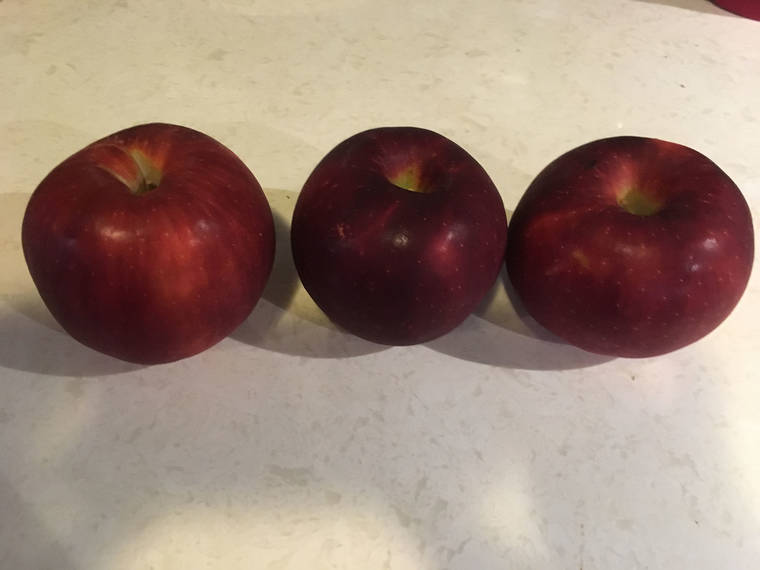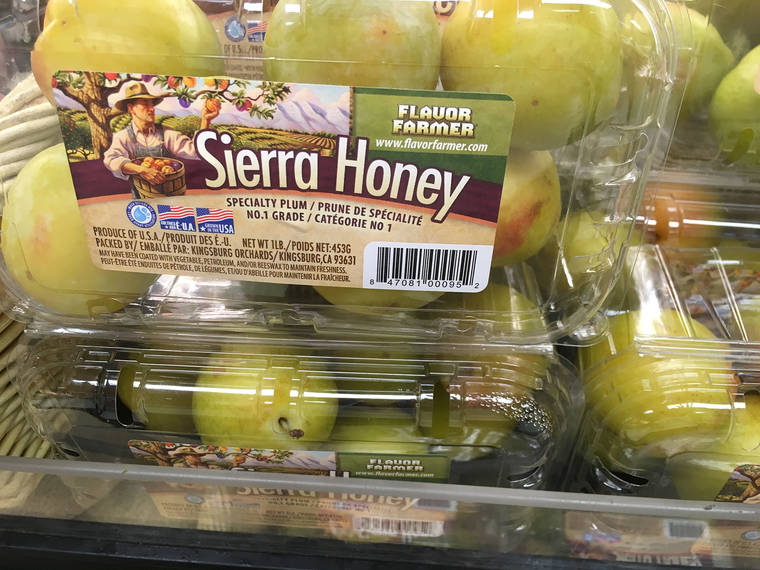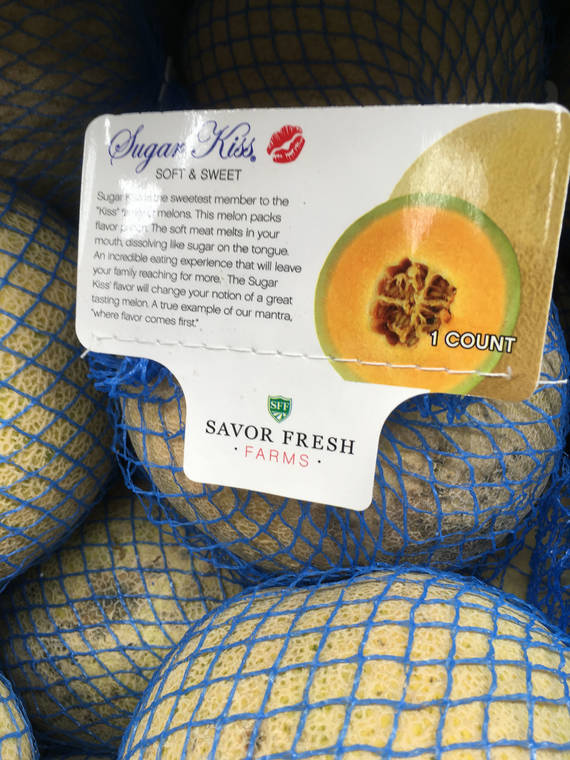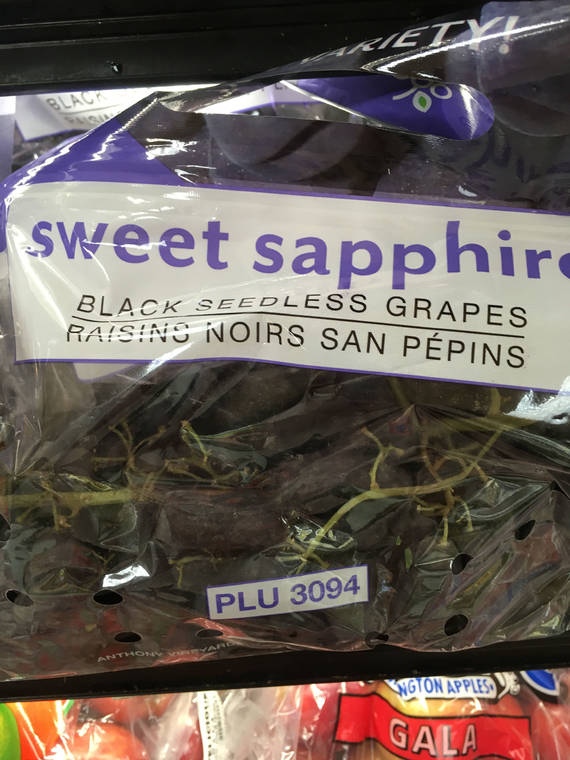Let’s Talk Food: Fruits in season




Kiss melons
Kiss melons
It is the season for Savor Fresh Farms Kiss melons.
ADVERTISING
Right now, the Sugar Kiss are at the markets, the sweetest of the Kiss family.
“This melon packs a punch of flavor. The soft meat melts in your mouth, dissolving like sugar on the tongue. An incredible enjoyable eating experience. With a texture reminiscent of the Crenshaw, the Sugar Kiss has unsurpassed flavor. The Sugar Kiss flavor will change your notion of a great tasting melon. A true example of our mantra, ‘where flavor comes first.’”
The other varieties are Golden Kiss, Honey Kiss and Summer Kiss. They are individually wrapped in netting with the labels attached.
After purchasing them, do not leave them out at room temperature. Refrigerate or cut them right away. I noticed if left out even one day, they tend to get soft and mushy.
Sierra Honey specialty plums
Flavor Farmer brand of fruits from Kingsburg Orchards is located in Central California’s San Joaquin Valley and specializes in white peaches, white nectarines, pluots, apple pears and apriums. In fact, they have more then 200 varieties of fresh fruits. Their latest addition, Sierra Honey plum is now available at markets.
“Plums are known for their firm texture, juiciness and tangy skin. Their skin colors range from yellow to red to black, and they have yellow or red flesh. The two major types of plums are Japanese and European varieties.”
Japanese plums are typically round or heart shaped and become ripe toward the beginning of the season. The European varieties are oval shaped and ripen later in the season. Plums are available from May-November. They are high in Vitamins C, K and A and are a good source of fiber. Th red-fleshed varieties are also high in antioxidants.
Sierra plums, also known as Klamath plums or Pacific plums, are a wild species botanically classified as Prunus subcordata. They are the only plum species native to the western United States and are named for their prevalence growing in the foothills of the Sierra Nevada Mountains. In the wild, these plums are a popular food for birds and deer.
Sierra plums are a good source of Vitamins C and A and fiber. They also contain copper, potassium, Vitamin K and B-complex vitamins. There also are small amounts of Vitamin E, folate, iron, magnesium, manganese, phosphorus, selenium, zinc and calcium.
These plums have been around a long time and were a part of the diets of Native American tribes in the Sierra Nevada Mountains of Northern California. The plums were picked ripe and dried for the winter. Trappers from the Hudson Bay Co. arrived in the region and found this fruit, which they called wild plum.
Sweet Sapphire black seedless grapes
An interesting variety of grapes now available, the Sweet Sapphire variety is black and elongated in shape. They are a new crossbreed from the farms around Mildura in Victoria and the in the Carnarvon region of Western Australia.
They have a dessert-sweet flavor and a nice snap when bitten into.
Rambutan
If you do not have a tree in your backyard, you can get a bag from your neighbor. Native to Malaysia, it is closely related to lychee and longan.
Rambutans have trace amounts of thiamine, riboflavin, niacin, Vitamin B3, folate, Vitamin C, calcium, iron, magnesium, manganese, phosphorus, potassium, sodium and zinc.
Star fruit or carambola
Native to Indonesia, the Philippines and Malaysia, star fruit is now in season. There are two main types: small and tart or larger and sweet. Most of the trees grown here are of the larger sweet type.
Because of the higher oxalic acid in the sweet type, as well as caramboxin, they are harmful to those suffering from kidney failure, kidney stones or on kidney dialysis.
Those with kidney problems can experience hiccups, vomiting, nausea, mental confusion and even death. Caramboxin is a neurotoxin that is structurally similar to phenylalanine, and is a 82% glutamatergic agonist.
Carambola and its juice in combination of certain prescription medications can inhibit the effectiveness or even eliminate its intended use, so check your label or consult your physician before eating star fruit.
Dragon fruit
A cactus, dragon fruit, or pitaya, is native to Mexico, Guatemala, Nicaragua, Costa Rica, El Salvador and northern South America.
One hundred grams of dragon fruit contains 268 calories, 82% carbohydrates, 4% protein and 11% of the daily value each for Vitamin C and calcium.
Apples
With the start of the fall season, look for apples, such as honeycrisp that say “New Crop,” as some of the apples might have been in storage for awhile from last year.
You will start hearing a lot about the newest apple from Washington state, the Cosmic Crisp. It will make its debut Dec. 3, and I will be writing about it then. I was sent samples and have to say it is all it says it is — crispy, juicy, sweet with a hint of tartness, perfect for just eating or baking.
Foodie bites
Hawaii Community College’s Culinary Arts program is open for business 10:30 a.m.-12:30 p.m. today through Friday. Call 934-2559 for takeout orders.
Orders are being taken for pumpkin pies, which can be picked up from 10 a.m.-2:30 p.m. Wednesday, Nov. 27. Call 934-2559 to place your order. If leaving a message, state your full name, phone number and quantity of pies ordering. Bring your own box or container when picking up the pies.
Email Audrey Wilson at audreywilson808@gmail.com.


